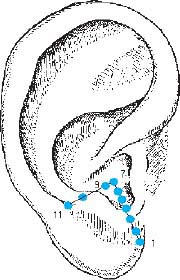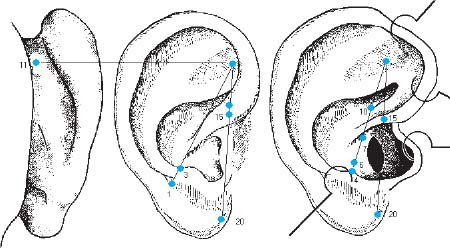Meridians on the Ear
The following symbols are used to identify the different types of points along each meridian:
(+) Tonification Point (Mother Point)
(-) Sedation Point (Son Point)
(L) Luo Point (Connecting Point, Passage Point)
(Y) Yuan Point (Source Point, Primary Qi Point)
(M) Master Point (Influential Point)
(C) Cardinal Point (Opening Point)
(H) He Point (Sea Point)
In the 1990s, Bahr and coworkers were able to determine the projection of all body meridians on the surface of the ear. This not only lead to new exciting insights into the significance of certain body acupuncture points, it also revealed that many well-known ear acupuncture points have a far wider spectrum of activity than previously assumed. For example:
Point HT-3 of body acupuncture projects onto the Heart Point (motor portion) on the back of the ear. Consequently, we advise patients with irregular heart beat (arrhythmia) or heart failure (cardiac insufficiency) to stimulate this body acupuncture point gently by acupressure or transcutaneous nerve stimulation (concomitant with their normal medication, if necessary), in order to support the ear acupuncture treatment. Point HT-3 is easily accessible in the crease of the elbow.
Point SI-3 of body acupuncture projects onto the Celiac Plexus Point on the back of the ear (Retro Point Zero). This ear point has a spasmolytic effect—just like Point SI-3 of body acupuncture—and is also one of the eight Cardinal Points on the ear. It is highly effective for treating Bechterew’s disease (ankylosing spondylitis) when used in combination with the ear point corresponding to Point BL-62.
In almost all cases, the Tonification Point (+) of the body meridian projects onto the respective Organ Point on the ear. For example, ST-41 (+) corresponds to the Stomach Point on the ear, LR-8 (+) corresponds to the Liver Point on the ear, and so forth. The only exception is H9 (+) which does not correspond to the Heart Point on the ear. Both LU-7 and LU-9 project within the Lung Zone on the ear, which represents the parenchyma of the lung.
In this book, the most important points of each ear meridian are described together with their multiple functions. They carry the same names as the corresponding body acupuncture points. Points ending with “-1” are located close to the original point (e.g., TB-1-1 lies close to TB-1).
Lung Meridian
Note: The points indicate the course of the ear meridian but not the metal type to be used for treatment.
| LU-1 | Anxiety Point (Silver Point on the right ear) or Worry Point (Silver Point on the left ear). | |
| LU-7 | Located in the Lung Zone; Cardinal Point indicated for strengthening the defense mechanism, Master Point for all affections of the respiratory tract. | |
| LU-9 | Located in the Lung Zone; Tonification Point, Master Point of the blood vessels. | |
| LU-11 | Tonsil Point. |
Large Intestine Meridian
Note: The points indicate the course of the ear meridian but not the metal type to be used for treatment.

Fig. 8.1 Lung Meridian

Fig. 8.2 Large Intestine Meridian
Stomach Meridian
Note: The points indicate the course of the ear meridian but not the metal type to be used for treatment.
| ST-36 | Caffeine Analogue Point (Gold Point on the right ear) or Barbiturate Analogue Point (Gold Point on the left ear). We may expect the same intensive, broad-spectrum effect from these ear points as from Point ST-36 of body acupuncture, for example, as He Point of the Stomach Meridian through which all meridians can be energetically influenced. | |
| The projection of the Stomach Meridian onto the ear has revealed an immensely broad spectrum of possible activities for many ear points that have been neglected so far. | ||
| ST-40 | Beta-2-Receptor (Beta-Mimetic) Point (Gold Point on the right ear) or Beta-1-Receptor (Beta-Blocker) Point (Gold Point on the left ear). | |
| ST-41 | Stomach Zone; Tonification Point. | |
| ST-45 |



